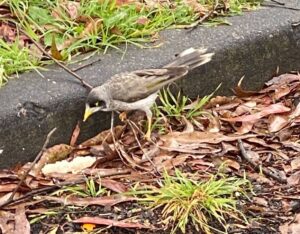Cat Scratching Post
No matter how cute and how cuddly your cat might seem, there’s always a little tiger lurking inside, waiting to get out and scratch your furniture. The solution to the problem is a scratching post. In the stores they cost about $50. Dr Chris Brown showed how you can make your own for around $20.
Materials and tools
Stanley knife
Screwdriver
Saw
Hot glue gun
Measuring tape
100mm dia. x .5m treated pine log
19mm pine, cut to 300 x 300mm
19mm pine, cut to 200 x 200mm
carpet off-cuts
5 x 100mm countersunk gal screws
4 x 50mm bullet head gal nails
Note: instead of using the pine post, you could use stormwater PVC pipe (100mm dia. x 500mm) with a cap and flange to fit above the pipe. You will also need 4 x 16mm self-tappers for screwing down the flange.
Construction
Timber
- Cut timber to 300mm x 300mm for the base and 200mm x 200mm for the top platform.
- Cut carpet squares 350mm x 350mm to cover base, and 250mm x 250mm to cover the top platform.
- Run a bead of glue around the top face of the timber base, adhere the carpet square and press until it goes off.
- Turn timber over so that carpet is underneath. A 25mm edge of carpet will be visible around the timber. Glue the edges of timber, one at a time, and adhere the carpet overhang to the edges. Hold until glue goes off. Repeat all sides and trim off excess.
- Repeat steps 2-4 for top platform.
- Measure and cut a piece of carpet longer than the diameter of the pine post.
- Run a bead of glue along the length of round timber and attach the underside edge of the carpet and allow it to go off.
- Place the loose flap of remaining carpet towards you with round timber on top and run a second bead of glue along the length of carpet and roll the timber towards you so that it joins with the bead of glue. Hold until it goes off.
- Repeat step 8 until the carpet is one-turn from completely covering the post. Trim the carpet overhang, run a final bead of glue and turn the last edge of carpet into meet the first edge, forming a neat join.
- Place post upright on centre of carpeted base and screw 5 x 100mm screws from the underside of the base, into the post.
- Flip over and place the small platform on the top of the post, centre and nail with bullet head nails below the surface of the carpet.
PVC
- If using the PVC pipe, follow steps one and two above, then place the flange dead centre on the underside of the carpet to be used to cover the base. Scribe out the inside diameter of the flange and cut the marked circle out of the carpet.
- Now fix flange dead centre on the timber base with 16mm self-tappers.
- Glue the carpet onto the base (the hole in the carpet should fit around the flange) and adhere the carpet to the base as per steps 3-5 above. Attach the cap to one end of the pipe (use a thin bead of glue if necessary).
- Repeat steps 6-9 above to attach carpet to the PVC pipe and trim top and bottom edges (the top edge should be flush, the bottom edge should be trimmed to allow for the depth of the pipe slipping into the flange).
- Glue the platform onto the top of the PVC pipe.



